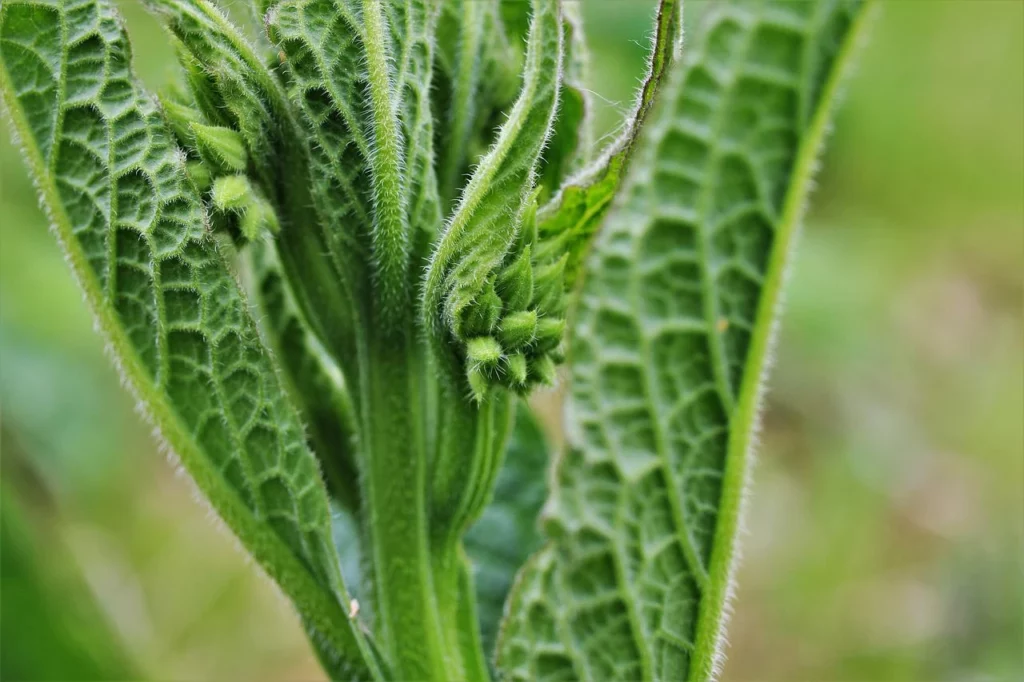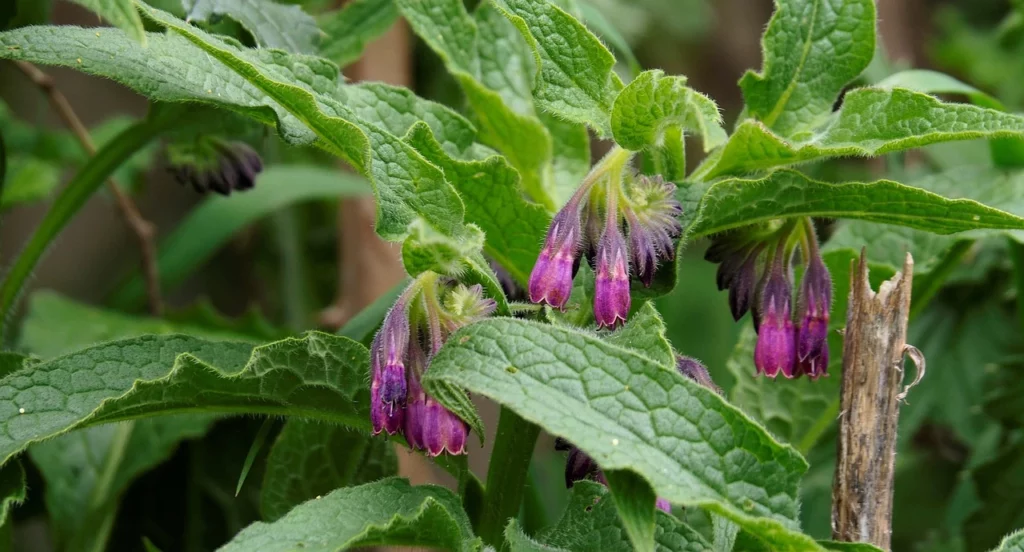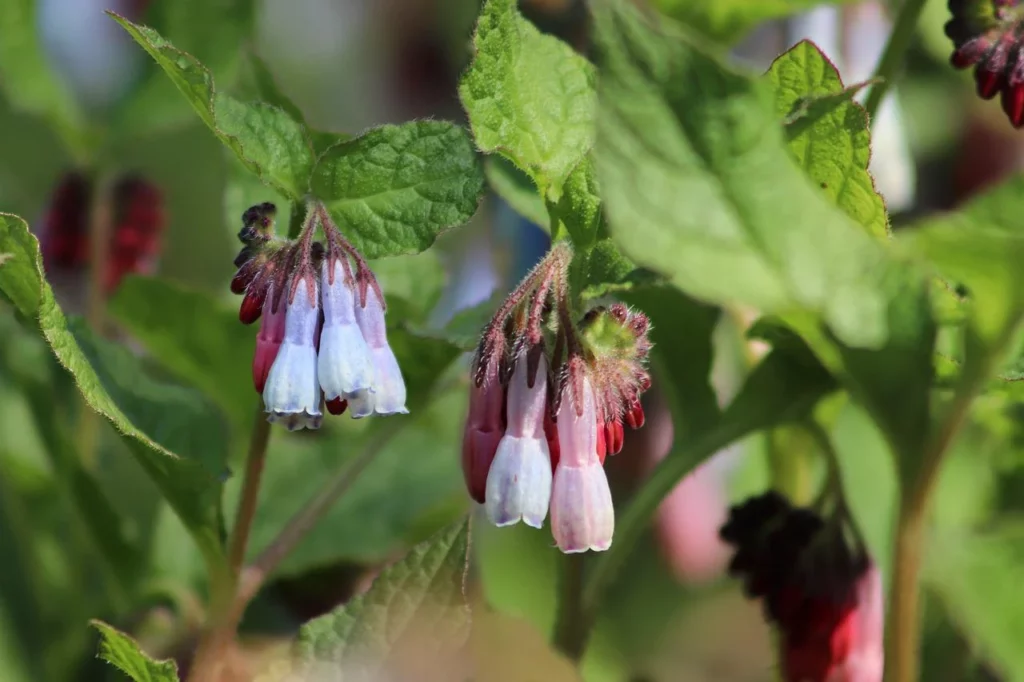Comfrey (Symphytum officinale) has long been used as a medicinal plant for its anti-inflammatory properties. It is also useful in the garden as a fertilizer and mulch material, and is also extremely attractive to bumblebees. Learn everything about planting, harvesting and using comfrey in this article.
Contents
What is comfrey?
Comfrey (Symphytum officinale), like forget-me-not (Myosotis), bee-lover (Phacelia tanacetifolia) and viper’s bugloss (Echium vulgare), belongs to the Boraginaceae family. It is known by many names: True Comfrey, Common Comfrey, Medicinal Comfrey, Comfrey, Fracturewort, Legwort, Painwort, or Comfrey. Many names already indicate its use as a medicinal plant.
Comfrey is mildly toxic and has analgesic and anti-inflammatory properties when used externally. It is used for broken bones, bruises and haematomas and is therefore mainly grown for medicinal purposes. However, the rough-leaved plant also cuts a good figure in the ornamental garden with its appearance.
What does comfrey look like?
Comfrey is a herbaceous perennial perennial that dies above ground in winter and sprouts again in spring. It grows to about 50 – 80 cm tall and 30 – 40 cm wide. The stem and leaves are bristly-haired, and the whole plant forms clumps with underground creeping stolons. The main root is a taproot and grows up to 50 cm long, it is dark brown-black outside, but white and mucilaginous inside. It is used primarily for medicinal purposes. The large leaves of the comfrey plant are oval-lanceolate and pointed at the front, they grow up to 25 cm long.
The flower color varies from white, purple, blue or pink, depending on the variety. The inflorescences are arranged in clusters and bear pendulous, bell-shaped individual flowers. They are pollinated almost exclusively by bumblebees and large wild bees, as these are specially adapted to the flower shape with their long proboscises. The flowering period extends from May to September. The flowers are often sterile and do not form seeds. If fertilization does occur, so-called cloistered fruits develop, which disintegrate into egg-shaped partial fruits. Propagation is usually vegetative via runners of the rhizome.

Origin
Comfrey is native to all of Europe from the Mediterranean to the Caucasus. As a native wild herb, it can be found in species-rich meadows and along forest and roadsides. In general, it prefers rather moist areas and therefore often grows along streams or ponds. The hardy perennial was already valued by the Romans as a medicinal herb and could not be missing in the medicinal garden of Hildegard von Bingen.
Location
Choose a sunny to semi-shady location for your comfrey plant. The soil may be somewhat heavier. A loamy, nutrient-rich and humus-rich soil is ideal for the perennial. The location should be moderately dry to moist, very dry places in the garden are rather unsuitable for the wild plant. Comfrey is well suited as an underplanting of shrubs and trees. Also on the banks of ponds or next to the compost heap are optimal conditions for comfrey.
Plant & Propagate
Comfrey tends to sprawl due to its underground runners and can therefore also be grown in large containers. Ensure good drainage and use a mixture of garden soil and sand as substrate. If you already have a perennial, you can easily propagate it. The plants have a great regenerative power, individual root pieces grow into strong new plants.
The most common method is vegetative propagation by cutting off root stolons in the spring or after flowering in the fall. Usually, part of the root (with buds) is cut off with a sharp spade in spring and transplanted. Pre-grown seedlings can be obtained at any well-stocked nursery or garden center. When planting, you should dig a generous planting hole and fill it additionally with potting soil. Plant individual perennials 40 x 50 cm apart.
Sowing
Sowing comfrey is also generally possible. It is done in the fall in pots, which overwinter in the cold frame, or in March on the warm windowsill. Use low-nutrient growing soil for cultivation, so the sprouts develop best. As an alternative to growing in pots, comfrey can also be sown directly in the open from April. The sowing depth is always 5 cm. After three weeks, transplant the young perennials into more nutrient-rich soil. From May, the young plants can then be placed in their final location. Once Beinweill is established, it is difficult to transplant due to its deep taproot.
The flowers are often sterile and do not produce seeds, so propagation is usually done vegetatively via runners from the rhizome. If seeds were formed after all, you can collect the whole seed stalks (cloistered fruits) in the fall, dry them, and store them until you sow them in the spring. Comfrey germination can be relatively irregular and can take up to 20 weeks. So sowing is not always successful, but for those who like to try, it is worth a try.

Care
As a wild plant, comfrey is very adaptable and easy to care for. It grows best in moist soil. Therefore, in the first year after planting, always water sufficiently so that the young plants grow well. Mulching with organic material helps keep moisture in the soil for a longer period of time. Once comfrey has really settled in, it can also tap water from the deeper soil layers through its taproot and won’t need as much extra watering; only in dry summers will you need to water occasionally.
Comfrey is a perennial plant and often stands in the same place for several years, so at some point the nutrient supply in the soil can become a bit poor. Especially if comfrey is abundant, you should fertilize it with some mature compost in the spring.
Cut the stems about 10 inches above the ground after flowering to prevent comfrey from velveting out and spreading uncontrollably. Pruning also encourages new shoots and bushy growth the next year. Occasionally, fungal diseases such as rust or powdery mildew can attack the perennial. Cut off diseased plant parts close to the ground and discard them. Do not compost the fungal remains, as the spores are very persistent.
Species & Varieties
The genus Comfrey (Symphytum), in English “Comfrey,” includes about 40 species native to Eurasia and North Africa. Within the species of comfrey (Symphytum officinale), there are several varieties. For example, the variety ‘Moulin Rouge’ is particularly decorative due to its purple flowers, it blooms mainly from May to July. But not only the comfrey is very popular in the garden. Caucasus comfrey (Symphytum grandiflorum) is also widespread and is often planted as an ornamental perennial. The variety here ranges from ‘Miraculum’ with white-pink-red flowers to ‘Hidcote Blue’ with deep red buds and whitish-pale blue flowers to ‘Blue Bells’ with large, blue-purple flowers and wine-red buds.
Harvest comfrey
Fresh leaves can be harvested year-round as needed. However, to avoid weakening the comfrey itself too much, only the non-flowering shoots should be harvested, and no more than four times a year. The roots are harvested only from biennial plants. Dug out in the fall, they are used dried or fresh.
Use in the garden
Because of its high potassium and phosphorus content, comfrey is used as a natural fertilizer in the garden. The nutrient-rich leaves are also especially good as a mulch for high-growing crops such as tomatoes, peppers, celery, head cabbage and potatoes. You can also chop the leaves and mix them with nettles. Comfrey can also act as a plant tonic and help diseased plants. Gooseberries affected by powdery mildew, for example, can become more resistant and robust by mulching with comfrey. In gardens with particularly heavy soils, comfrey can be used to naturally improve the soil. The strong taproots help to loosen the soil and ensure better aeration of compacted areas.
Comfrey liquid manure
In addition to nitrogen, comfrey also contains particularly high levels of phosphorus and potassium, as well as numerous micronutrients and silica. The decoction is used for fertilization and as a plant-strengthening herbal liquid manure. The nutrient-rich slurry can help make your vegetable plants and shrubs more resistant to disease and pests. Because of its high potassium content, comfrey liquid manure is especially good for crops that need potassium, such as tomatoes, potatoes and berries.
Comfrey liquid manure is made on the same principle as nettle liquid manure. Put the leaves in a plastic bucket and fill it with water. Then cover it and let the mixture stand, stirring occasionally, for about six weeks. Before use, dilute one part of the liquid manure with 10-15 parts of water.
Comfrey: effect as a medicinal plant
Comfrey has been used as a medicinal plant since ancient times. It has analgesic, wound-healing and anti-inflammatory effects and can be made into ointments, gels or other comfrey extracts. The most common is comfrey ointment, which is made from the roots of the plant (rarely from the leaves). It is used mainly for sports injuries such as strains and bruises, but also for rheumatic pain. Comfrey ointment or comfrey poultices made from cleaned, finely grated comfrey roots have also proven effective for osteoarthritis, bursitis, and broken bones. For weak sprains, compresses with comfrey leaves can already provide relief.
Comfrey should only be used externally and not on open wounds due to its toxic inhalants. Its effective ingredients are numerous: allantoin, saponins, phythosterols, various mucilages and tannins, rosmarinic acid, resins and silicic acid provide rapid relief from various ailments. In addition, the pyrrolizidine alkaloids, which can have a toxic effect on organs and tissues when used internally, are typical of rough-leaf plants.
The contained allantoin promotes, among other things, the formation of new bone substance (callus) and thus the coalescence of the bones. The scientific name Symphytum, as well as the European name “Wallwurz” (from old European “wallen” = to grow together) points to these properties. The most common name comfrey is derived from the word “leg”, which was formerly used for bones (bones).
Make comfrey ointment
Comfrey ointment is very easy to make yourself and helps with sprains, bruises, muscle tension, joint pain and bruises. To make comfrey ointment from comfrey root, first make an oil extract. To do this, cut the cleaned roots nice and small or grate them and soak them in olive oil for four to six weeks in a closed container. Then the extract is warmed with beeswax, so that when it cools down, a thickened ointment is formed.
Comfrey is a plant with many benefits and a long tradition. We hope this insight has inspired you to incorporate comfrey into your own garden.


